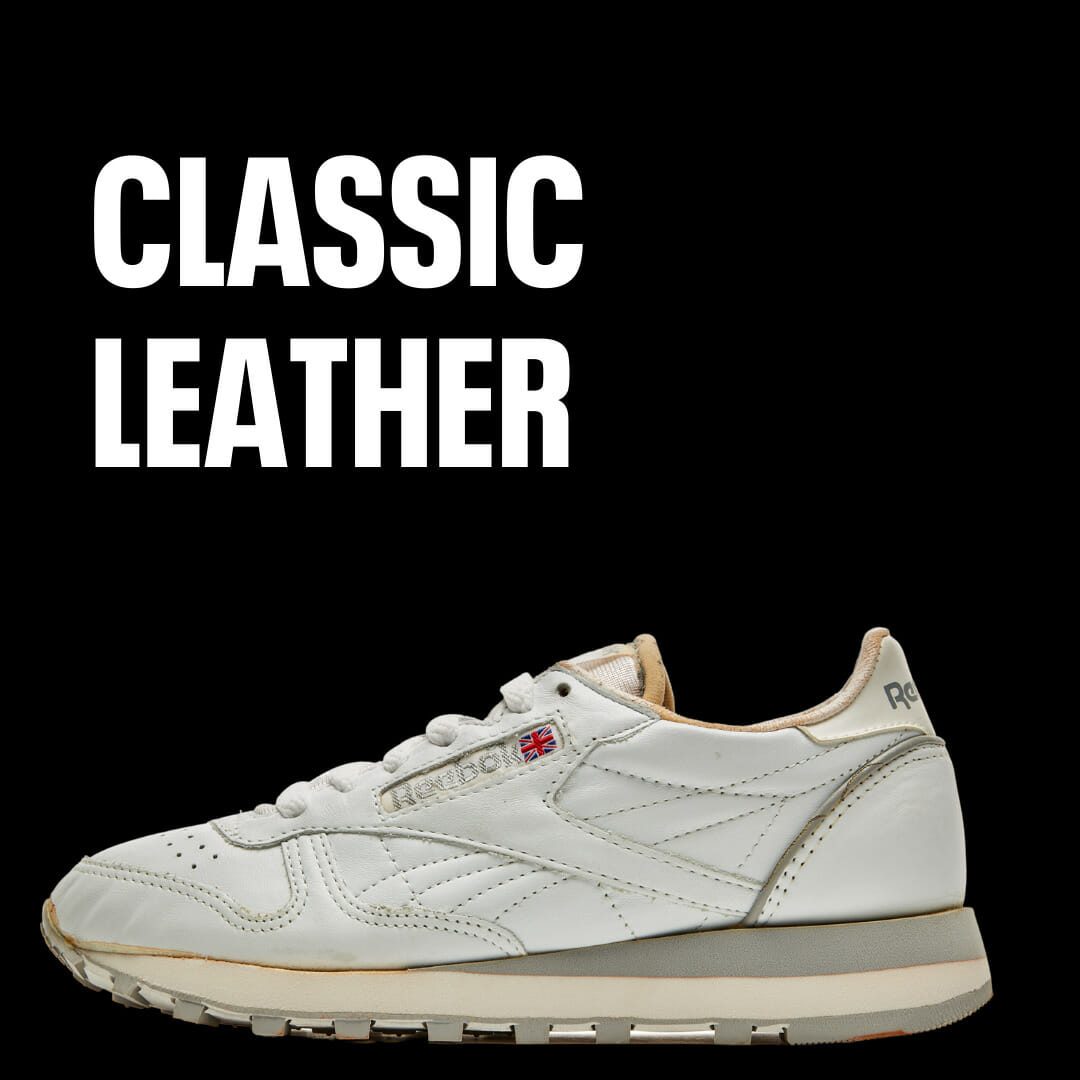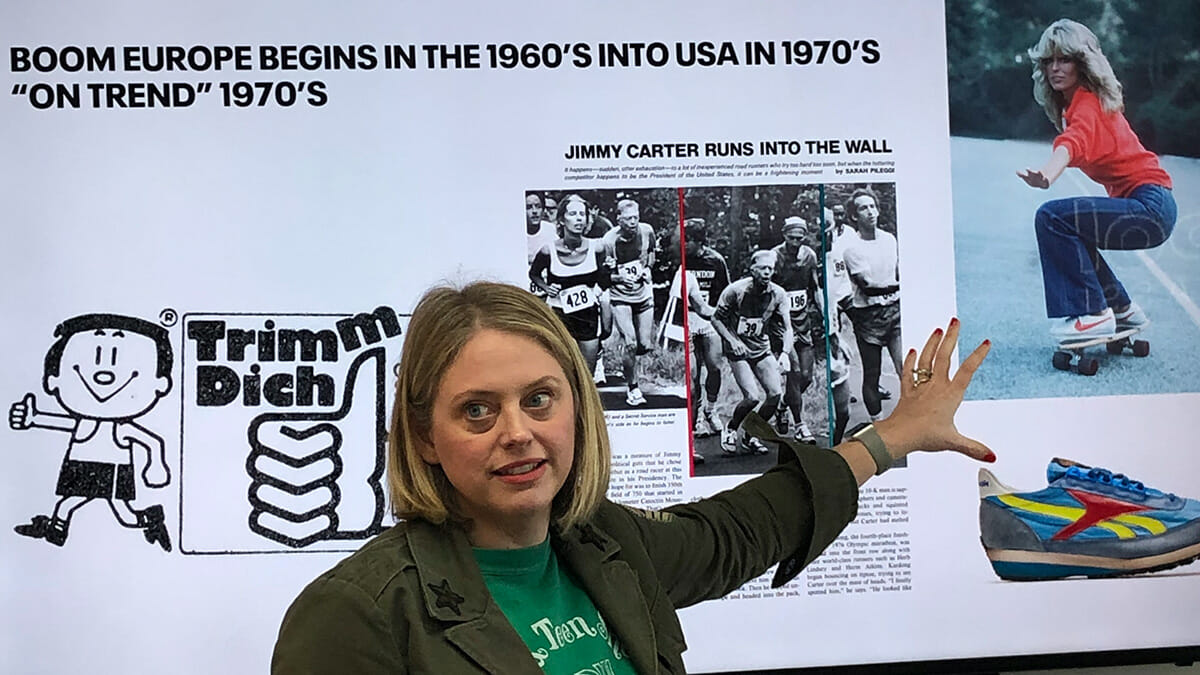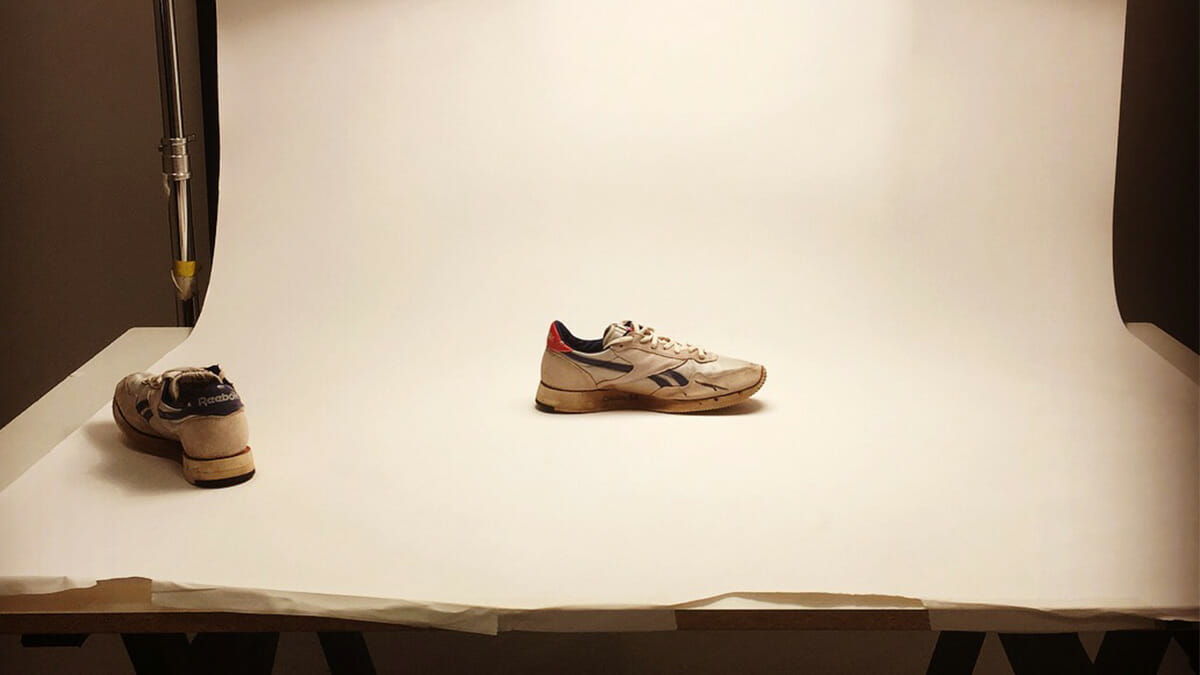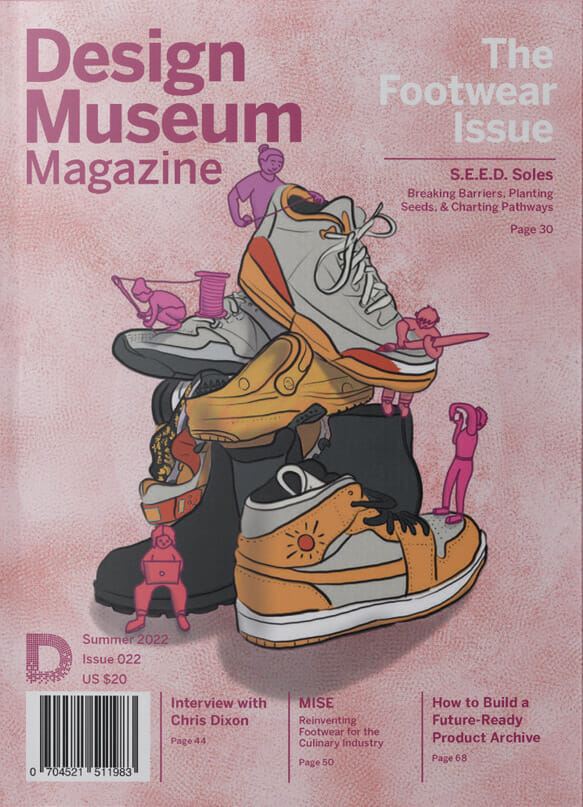How to build a future-ready product archive
(Preview)

By Erin Narloch, Founder & Consultant, PastForward Head of Web3, Enwoven
Background & The Challenge
When I joined Reebok in the summer of 2016, their archive project was already underway. The project had transformed from taking place in a single office room in an outbuilding with an archive consisting of only ten shoes, to an expansive space in a then sprawling suburban Boston campus. The archive team consisted of two parttime temporary staff members who had graduated from their previous intern roles and one intern. They sat on a holding of confirmation samples, historic pieces, advertisements, documents, and ephemera. This collection held incredible potential; it became my role to unleash it.
The term “brand archive” in this article references a brand’s physical product archives, especially ones that are utilized throughout the seasonal design process. Brand Archives can comprise a variety of physical assets, documents, catalogs, commercials, products, ephemera, advertisements, design drawings, and more. Archives are important in cracking the “Viewing Vacuum,” a term widely utilized within the cultural sector, which refers to viewing an object today without its context, inherent historic material culture, value, or use.
So why was Reebok interested in creating a brand archive? If done successfully, Reebok, its employees (past and present), brand partners, media outlets, sneakerheads, and fans could tell stories, build products, and create marketing strategies and activations in a more authentic way, leading to increase brand awareness and confidence.
The question remained: How do you build and position an archive to hold and grow brand value in an increasingly iterative, digital minutia-laden world?
These are the steps we took at Reebok to position its product archive for the future.
The Reebok Archive Design Process: Lean in with curiosity
During my first months, I set forth a plan, beginning with researching the intranet’s organizational charts and identifying key stakeholders and decision makers. The individuals represented the brand’s activities, general managers of key business units and leadership within marketing, product, design, creative direction, and legal departments. Once I outlined a set of individuals, I set up meetings with each of them. As a researcher at heart, I sifted through the online organizational charts and acquainted myself with who I could meet. When I met with them, I’d ask a set of standardized questions: Do you utilize the archive today? If so, how? How could we support your workflows & processes? What would a successful archive look like to you? Is there anything about Reebok’s past that you’d like to know more about?
In many cases, I was met with the “I don’t know,” even from individuals like the senior director of marketing for the heritage product line. I immediately followed up with more openended questions such as, “Can you tell me more about how your team creates marketing briefs?” In the moment, I’d often make suggestions as to how the archive could provide a value-add to the process, such as “Do you think it would be helpful if the archive team provided examples of historic advertisements that took on either the same product, creative angle, or target audience?” I’d also write down all of the words and acronyms I wasn’t familiar with to learn later. I knew to “fit in,” I needed to adopt the corporate lingo.

Erin Narloch, presenting research on the running boom of the 1970s and the aerobics boom of the 1980s
Present a clear ROI
By the fall of 2016, I’d gathered enough evidence from my informational chats with stakeholders, observations of the working archive team, and insight into the brand’s future plans to present the business case for an official archive and team. I presented a proposal to my manager, VP of Reebok Futures, and HR. I clearly outlined the department’s mission, vision, goals, and a team structure.
Roles covered the major activities of the brand, footwear and packaging, apparel and accesso-ries, and documents and advertisements. Team responsibilities were to dive-deep in their respec-tive collections and become authorities on them. I led brand-level storytelling initiatives and proj-ects. I positioned the archive as a brand-wide service provider, with a team of subject matter experts to support the major activities of the brand:
I also outlined what would be possible with a full-time permanent team: how we could divide and conquer and become even more knowledgeable and a greater-asset for the brand over time. Professionalizing the archive required an investment from the brand that delivered new support, expertise, and results.
Utilize business initiatives
The Archive benefited from two key business initiatives and events. In the fall of 2016, one initiative provided the budget for the archive to pilot digital storytelling with Enwoven, a Silicon Valley tech startup with New York Times backing. Investing in a digital storytelling platform was transformative for the archive. It provided the opportunity to tell stories to a global community, educate, engage, and shine a light on processes, little-known campaigns, and share the first-person narratives of previous designers, inno-vators, and the founder of Reebok. Each story was penned by the archive team, so visitors to the site had the benefit of hearing from the experts directly. By 2018, we launched SSO for the global organization, removing a barrier to entry.
Another key initiative of Reebok and our then parent company, Adidas, was moving operations from suburbia to the up-and-coming area of Boston’s Seaport. This was an immense move, during which the archive received unimaginable benefits. These benefits included donations, as individuals cleaned out their desks and workspaces. We developed an intake form that controlled the process and made it feel more secure. Designing an archive space in the new building was exhilarating. We worked directly with Gensler, discussing how we envisioned our future working space. The key aspects of the build included a meeting room framed with large panes of glass, where we could meet with employees, collaborators, even VIP visitors as well as present changing exhibitions (which complimented current milestones within the business). Beyond the meeting room, we had a large window into the archive that provided passersby an inside view into the always curious space of the physical archive. We now had a physical archive with humidity and temperature control, high-density mobile storage, and working spaces for each Archive team member. This space is centrally located between the product organization and creative direction, proving to be corporate real estate gold.
Democratize knowledge
As an archive team, we worked diligently to share what we knew and what we discovered and to respond to requests. This process helped to build community, trust, and a broad investment from Reebok. Over time, the digital archive became a global hub of activity: an onboarding tool, research tool, and the first line of inquest for many.
The concept of democratizing knowledge didn’t end with the Reebok community; over the course of five years, the archive showed up in numerous marketing activities of the brand, including in pop-up exhibitions spanning the US, Europe, and Asia, inspiring messaging and marketing campaigns globally and in-market, and contributing to the re-launch of the Reebok Human Rights Award in 2020-2021. The power of the archive became tangible because it was shared, not hidden away.
Contextualize Content
As mentioned before, the archive fights against the “Viewing Vacuum.” Within sneaker history, the archival process represented an opportunity to dig deeper and research the cultural implications of the time, a shoe’s commercial success, community adoption, or even material usage. Within the archive we worked hard to contextualize the collection’s holdings through outside experts, experiences that intersected with the collection, and secondary sources at the time. The value of a shoe’s context is found in both its commercial and cultural significance over time.
Digital-first mindset
Thinking digitally in the archive created a shorter runway to success. Scanning, photography, web-based collections management, and the digital archive tool placed much of our focus on how the research and knowledge we held could be shared digitally. This mindset meant that when COVID hit, we went remote, we were positioned to support our colleagues and requests without missing a beat. A great example of this was when the archive was included in hosting global virtual onboarding and lunch and learns; we utilized Microsoft Teams to record sessions, and the infrastructure provided by the digital archive allowed us to represent stories already in existence on the platform.
Having access to resident experts in the archive meant the space and its contents could be used to suppport business initiatives, it doesn’t mean others needed to be an expert to visit or find value in the archive. Key to its success, we didn’t layer in academic language, but rather considered the most inclusive ways to story tell. Thanks to my experience in early meetings, I researched and integrated the language of the business throughout my time with the archive. Personally, I use the phrase, “where memory meets imagination to fuel the future” to describe the archive. This notation epitomizes my approach to brand archives: it’s a nexus, where past, present, and future exchange with one another, and where colleagues and creatives find inspiration and confidence. It’s here in the in-between, time is suspended, and insight is found. This is the magic of brand archives, a future-proof approach to the dynamic exchange of the real, authentic, and not yet realized. And this is the reason I firmly believe brand archives will be even more significant in the future.

Photoshoot of Steve Jones’s 1985 World Record holding shoes (signed)
The Impact
Over the course of two and a half years (2016 – 2019), the Reebok Archive went from being housed in an outbuilding, to being centrally located and accessed by the product, design, marketing, creative direction, legal, and other departments. The Archive traveled from the periphery to a participant in the product creation process. The impact of the Reebok Archive is challenging to succinctly articulate. but it can easily be experienced in in the community it builds, the knowledge it shares, and the product and storytelling it reinforces. While Reebok has a long heritage to draw upon– since 1895!– it’s the living brand archive that keeps it dynamic, active, and tangible. I led Reebok’s Brand Archive for over five years; before that I spent two years at the adidas Brand Archive, and before that, over a decade in museums and cultural institutions. And while I’ve spent much of my career studying the past, it’s the application of this knowledge into the future I’m most excited about. I moved on from Reebok in January 2022 to step into the future.
I’m heading up the newly created Web3 practice at Enwoven, because I’m convinced there’s power in the medium’s future, especially for brands. The metaverse offers a direct to consumer communication channel that values dialogue in lieu of one-way pushes, calls for authentic storytelling, and encourages creativity. Other brand archivists and historians feel similarly about the space’s opportunities, like Catherine Acosta, product archivist and historian for Vans. Catherine noted, “Product archives and historical content in general will hold a special place within the metaverse because of their symbolic representations of past ideas and stories. The metaverse has the potential to emphasize the complex meanings of objects and the various things they represent to different people and cultures. Recontextualizing history and archives in this way, would not just allow history or historical content to encompass “the facts” but also the interpretation(s) of history itself—a meta-approach that can integrate micro and macro thinking, and allow for imaginative and creative relationships to develop to the past.”
Vanessa Ayer, Senior Image Specialist, Kohler Co., sees the benefits of Web 3 for product archives while also calling attention to the mindfulness needed around ownership and copyright laws in this emerging space. Vanessa explained, “The future of NFT’s can be great for product archives. NFT’s can be used to document the history of a company while also creating a connection with consumers—also giving them an opportunity to “own” a piece of history. However, brands would need to be mindful of ownership and copyright laws.”
Tonya Blazio-Licorish, Archives Content Developer, PMC errs on the side of optimistic caution when it comes to Web 3: “As exciting as this technology is (and not exactly new), I believe brand (product) archives can be beneficial in expounding product history and reengaging through a more exciting UX/UI experience. But should be careful in this space, especially with this new technology as a marketing tool for brands it’s still very much quality over quantity.”
Tracey Panek, Historian, and Director, Levi Strauss & Co Archives framed up her excitement through a recent application of technology at Levi’s. “One thing that excites me in my role as the Levi Strauss & Co. Archives Director is how to apply new digital technologies to our collection. We recently finished our first 3-D scanning project in the archives, capturing amazing images of five of our late 1800s Levi’s jeans that are nearly 150 years old. The detail is amazing, from the denim wear and fit to design details like the pocket stitching, but in a dimensionality we haven’t had before. I’ve been thinking of the myriad of potential uses—online exhibitions, design showrooms, in-house sample creation, or NFTs. I love the thought of blending history, design, and technology to inspire and excite new audiences. It opens a whole new world of possibilities!”
Regardless of where you sit as it relates to product archives, or the metaverse, this revolution is happening all around us in real time. I encourage you to invest in documenting your institution’s knowledge (think: product archive and IP on chain) and not to do so only to look back, but rather to boldly march into the future. When the real and authentic are transparently secured on the blockchain, we can collectively tell stories, share value, and engage in a new frontier for communication, extending a brand’s reach and meaning into the metaverse. See you in the future.
